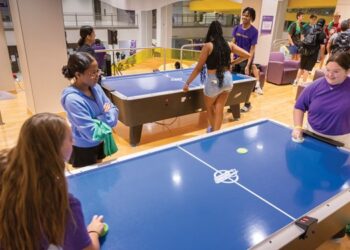Every morning I check my Fitbit app to understand how I’ve slept and each night I log what I’ve eaten and how many steps I’ve managed to squeeze in. I love data and our measurement tools are only improving. I’m now conditioned to want to know what I’ve done to inform my next decisions—“lots of calories today, better do extra cardio tomorrow, buddy,” I say to myself as I drift into sleep.
It’s no different in my line of work as an architect working with campuses aspiring to support student involvement in recreation and wellness programs. Post-occupancy evaluations on campus recreation projects are incredibly valuable exercises. Changing trends in fitness have implications on spatial decisions: open areas provide flexibility for underutilized equipment to be swapped out for turf strips, truck tires, and sleds popularized by CrossFit; nutrition counselors and massage therapists are often co-located with recreation to make holistic wellness accessible; the influx of international students means sports like cricket and ping pong are exploding; and once-ubiquitous juice bars are being converted to retail pro shops, which help fill a revenue gap for many campus recreation departments. Developments like these greatly impact how we design for flexibility. And when clients have access to this same data, they often make better decisions and trade-offs.
The campus recreation community has an uncommonly generous view toward knowledge-sharing with peer institutions. Post-occupancy studies are another useful input for these communities for a few reasons: 1) They allow our clients to demonstrate to administrations just how effective their buildings and programs are in supporting school missions. 2) They provide rich insights for peers embarking on a new construction or renovation project. 3) As designers, we can advise clients better and design smarter. 4) Students ultimately get better facilities. These are wins all around.
The next frontier for these studies is to go beyond program impacts, spatial feedback and material performance to rigorously measure mechanical systems and building envelopes so we can assess whether buildings live up to energy targets. Gathering data serves to do more than satiate our curiosity; if we are to build facilities of the future that allow clients to be competitive, we must go beyond design intuition. Taking to heart a lesson from the sports world, understanding where we can improve is crucial to being prepared when performance counts.
Bill Massey, AIA, Sasaki Architect and Principal. For more information he can be reached at bmassey@sasaki.com.










